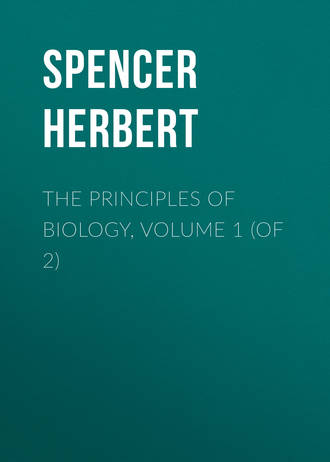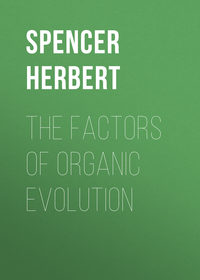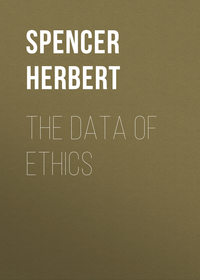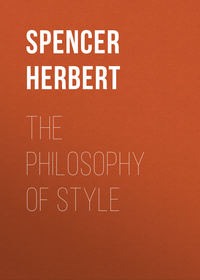 полная версия
полная версияThe Principles of Biology, Volume 1 (of 2)
Many parts of this complex process are still imperfectly understood, and various opinions concerning them are current. But the essential facts are that this peculiar substance, the chromatin, at other times existing dispersed, is, when division is approaching, gathered together and dealt with in such manner as apparently to insure equal quantities being bequeathed by the mother-cell to the two daughter-cells.
§ 74d. What is the physiological interpretation of these structures and changes? What function does the nucleus discharge; and, more especially, what is the function discharged by the chromatin? There have been to these questions sundry speculative answers.
The theory espoused by some, that the nucleus is the regulative organ of the cell, is met by difficulties. One of them is that, as pointed out in the chapter on "Structure," the nucleus, though morphologically central, is not central geometrically considered; and that its position, often near to some parts of the periphery and remote from others, almost of itself negatives the conclusion that its function is directive in the ordinary sense of the word. It could not well control the cytoplasm in the same ways in all directions and at different distances. A further difficulty is that the cytoplasm when deprived of its nucleus can perform for some time various of its actions, though it eventually dies without reproducing itself.
For the hypothesis that the nucleus is a vehicle for transmitting hereditary characters, the evidence seems strong. When it was shown that the head of a spermatozoon is simply a detached nucleus, and that its fusion with the nucleus of an ovum is the essential process initiating the development of a new organism, the legitimate inference appeared to be that these two nuclei convey respectively the paternal and maternal traits which are mingled in the offspring. And when there came to be discerned the karyokinesis by which the chromatin is, during cell-fission, exactly halved between the nuclei of the daughter-cells, the conclusion was drawn that the chromatin is more especially the agent of inheritance. But though, taken by themselves, the phenomena of fertilization seem to warrant this inference, the inference does not seem congruous with the phenomena of ordinary cell-multiplication – phenomena which have nothing to do with fertilization and the transmission of hereditary characters. No explanation is yielded of the fact that ordinary cell-multiplication exhibits an elaborate process for exact halving of the chromatin. Why should this substance be so carefully portioned out among the cells of tissues which are not even remotely concerned with propagation of the species? If it be said that the end achieved is the conveyance of paternal and maternal qualities in equal degrees to every tissue; then the reply is that they do not seem to be conveyed in equal degrees. In the offspring there is not a uniform diffusion of the two sets of traits throughout all parts, but an irregular mixture of traits of the one with traits of the other.
In presence of these two suggested hypotheses and these respective difficulties, may we not suspect that the action of the chromatin is one which in a way fulfils both functions? Let us consider what action may do this.
§ 74e. The chemical composition of chromatin is highly complex, and its complexity, apart from other traits, implies relative instability. This is further implied by the special natures of its components. Various analyses have shown that it consists of an organic acid (which has been called nucleic acid) rich in phosphorus, combined with an albuminous substance: probably a combination of various proteids. And the evidence, as summarised by Wilson, seems to show that where the proportion of phosphorized acid is high the activity of the substance is great, as in the heads of spermatozoa; while, conversely, where the quantity of phosphorus is relatively small, the substance approximates in character to the cytoplasm. Now (like sulphur, present in the albuminoid base), phosphorus is an element which, besides having several allotropic forms, has a great affinity for oxygen; and an organic compound into which it enters, beyond the instability otherwise caused, has a special instability caused by its presence. The tendency to undergo change will therefore be great when the proportion of the phosphorized component is great. Hence the statement that "the chemical differences between chromatin and cytoplasm, striking and constant as they are, are differences of degree only;" and the conclusion that the activity of the chromatin is specially associated with the phosphorus.26
What, now, are the implications? Molecular agitation results from decomposition of each phosphorized molecule: shocks are continually propagated around. From the chromatin, units of which are thus ever falling into stabler states, there are ever being diffused waves of molecular motion, setting up molecular changes in the cytoplasm. The chromatin stands towards the other contents of the cell in the same relation that a nerve-element stands to any element of an organism which it excites: an interpretation congruous with the fact that the chromatin is as near to as, and indeed nearer than, a nerve-ending to any minute structure stimulated by it.
Several confirmatory facts may be named. During the intervals between cell-fissions, when growth and the usual cell-activities are being carried on, the chromatin is dispersed throughout the nucleus into an irregular network: thus greatly increasing the surface of contact between its substance and the substances in which it is imbedded. As has been remarked, this wide distribution furthers metabolism – a metabolism which in this case has, as we infer, the function of generating, not special matters but special motions. Moreover, just as the wave of disturbance a nerve carries produces an effect which is determined, not by anything which is peculiar in itself, but by the peculiar nature of the organ to which it is carried – muscular, glandular or other; so here, the waves diffused from the chromatin do not determine the kinds of changes in the cytoplasm, but simply excite it: its particular activities, whether of movement, absorption, or structural excretion, being determined by its constitution. And then, further, we observe a parallelism between the metabolic changes in the two cases; for, on the one hand, "diminished staining capacity of the chromatin [implying a decreased amount of phosphorus, which gives the staining capacity] occurs during a period of intense constructive activity in the cytoplasm;" and, on the other hand, in high organisms having nervous systems, the intensity of nervous action is measured by the excretion of phosphates – by the using up of the phosphorus contained in nerve-cells.
For thus interpreting the respective functions of chromatin and cytoplasm, yet a further reason may be given. One of the earliest general steps in the evolution of the Metazoa, is the differentiation of parts which act from parts which make them act. The Hydrozoa show us this. In the hydroid stage there are no specialized contractile organs: these are but incipient: individual ectoderm cells have muscular processes. Nor is there any "special aggregation of nerve-cells." If any stimulating units exist they are scattered. But in the Medusa-stage nerve-matter is collected into a ring round the edge of the umbrella. That is to say, in the undeveloped form such motor action as occurs is not effected by a specialized part which excites another part; but in the developed form a differentiation of the two has taken place. All higher types exhibit this differentiation. Be it muscle or gland or other operating organ, the cause of its activity lies not in itself but in a nervous agent, local or central, with which it is connected. Hence, then, there is congruity between the above interpretation and certain general truths displayed by animal organization at large. We may infer that in a way parallel to that just indicated, cell-evolution was, under one of its aspects, a change from a stage in which the exciting substance and the substance excited were mingled with approximate uniformity, to a stage in which the exciting substance was gathered together into the nucleus and finally into the chromosomes: leaving behind the substance excited, now distinguished as cytoplasm.
§ 74f. Some further general aspects of the phenomena appear to be in harmony with this interpretation. Let us glance at them.
In Chapters III and IIIA of the First Part, reasons were given for concluding that in the animal organism nitrogenous substances play the part of decomposing agents to the carbo-hydrates – that the molecular disturbance set up by the collapse of a proteid molecule destroys the equilibrium of sundry adjacent carbo-hydrate molecules, and causes that evolution of energy which accompanies their fall into molecules of simpler compounds. Here, if the foregoing argument is valid, we may conclude that this highly complex phosphorized compound which chromatin contains, plays the same part to the adjacent nitrogenous compounds as these play to the carbo-hydrates. If so, we see arising a stage earlier that "general physiological method" illustrated in § 23f. It was there pointed out that in animal organisms the various structures are so arranged that evolution of a small amount of energy in one, sets up evolution of a larger amount of energy in another; and often this multiplied energy undergoes a second multiplication of like kind. If this view is tenable, we may now suspect that this method displayed in the structures of the Metazoa was initiated in the structures of the Protozoa, and consequently characterizes those homologues of them which compose the Metazoa.
When contemplated from the suggested point of view, karyokinesis appears to be not wholly incomprehensible. For if the chromatin yields the energy which initiates changes throughout the rest of the cell, we may see why there eventually arises a process for exact halving of the chromatin in a mother-cell between two daughter-cells. To make clear the reason, let us suppose the portioning out of the chromatin leaves one of the two with a sensibly smaller amount than the other. What must result? Its source of activity being relatively less, its rate of growth and its energy of action will be less. If a protozoon, the weaker progeny arising by division of it will originate an inferior stirp, unable to compete successfully with that arising from the sister-cell endowed with a larger portion of chromatin. By continual elimination of the varieties which produce unequal halving, necessarily at a disadvantage if a moiety of their members tend continually to disappear, there will be established a variety in which the halving is exact: the character of this variety being such that all its members aid the permanent multiplication of the species. If, again, the case is that of a metazoon, there will be the same eventual result. An animal or plant in which the chromatin is unequally divided among the cells, must have tissues of uncertain formation. Assume that an organ has, by survival of the fittest, been adjusted in the proportions and qualities of its parts to a given function. If the multiplying protoplasts, instead of taking equal portions of chromatin, have some of them smaller portions, the parts of the organ formed of these, developing less rapidly and having inferior energies, will throw the organ out of adjustment, and the individual will suffer in the struggle for life. That is to say, irregular division of the chromatin will introduce a deranging factor and natural selection will weed out individuals in which it occurs. Of course no interpretation is thus yielded of the special process known as karyokinesis. Probably other modes of equal division might have arisen. Here the argument implies merely that the tendency of evolution is to establish some mode. In verification of the view that equal division arises from the cause named, it is pointed out to me that amitosis, which is a negation of mitosis or karyokinesis, occurs in transitory tissues or diseased tissues or where degeneracy is going on.
But how does all this consist with the conclusion that the chromatin conveys hereditary traits – that it is the vehicle in which the constitutional structure, primarily of the species and secondarily of recent ancestors and parents, is represented? To this question there seems to be no definite answer. We may say only that this second function is not necessarily in conflict with the first. While the unstable units of chromatin, ever undergoing changes, diffuse energy around, they may also be units which, under the conditions furnished by fertilization, gravitate towards the organization of the species. Possibly it may be that the complex combination of proteids, common to chromatin and cytoplasm, is that part in which the constitutional characters inhere; while the phosphorized component, falling from its unstable union and decomposing, evolves the energy which, ordinarily the cause of changes, now excites the more active changes following fertilization. This suggestion harmonizes with the fact that the fertilizing substance which in animals constitutes the head of the spermatozoon, and in plants that of the spermatozoid or antherozoid, is distinguished from the other agents concerned by having the highest proportion of the phosphorized element; and it also harmonizes with the fact that the extremely active changes set up by fertilization are accompanied by decrease of this phosphorized element. Speculation aside, however, we may say that the two functions of the chromatin do not exclude one another, but that the general activity which originates from it may be but a lower phase of that special activity caused by fertilization.27
§ 74g. Here we come unawares to the remaining topic embraced under the title Cell-Life and Cell-Multiplication. We pass naturally from asexual multiplication of cells to sexual multiplication – from cell-reproduction to cell-generation. The phenomena are so numerous and so varied that a large part of them must be passed over. Conjugation among the Protophyta and Protozoa, beginning with cases in which there is a mingling of the contents of two cells in no visible respect different from one another, and developing into a great variety of processes in which they differ, must be left aside, and attention limited to the terminal process of fertilization as displayed in higher types of organisms.
Before fertilization there occurs in the ovum an incidental process of a strange kind – "strange" because it is a collateral change taking no part in subsequent changes. I refer to the production and extrusion of the "polar bodies." It is recognized that the formation of each is analogous to cell-formation in general; though process and product are both dwarfed. Apart from any ascribed meaning, the fact itself is clear. There is an abortive cell-formation. Abortiveness is seen firstly in the diminutive size of the separated body or cell, and secondly in the deficient number of its chromosomes: a corresponding deficiency being displayed in the group of chromosomes remaining in the egg – remaining, that is (on the hypothesis here to be suggested), in the sister-cell, supposing the polar body to be an aborted cell. It is currently assumed that the end to be achieved by thus extruding part of the chromosomes, is to reduce the remainder to half the number characterizing the species; so that when, to this group in the germ-cell, the sperm-cell brings a similarly-reduced group, union of the two shall bring the chromosomes to the normal number. I venture to suggest another interpretation. In doing this, however, I must forestall a conclusion contained in the next chapter; namely, the conclusion that gamogenesis begins when agamogenesis is being arrested by unfavourable conditions, and that the failing agamogenesis initiates the gamogenesis. Of numerous illustrations to be presently given I will, to make clear the conception, name only one – the formation of fructifying organs in plants at times when, and in places where, shoots are falling off in vigour and leaves in size. Here the successive foliar organs, decreasingly fitted alike in quality and dimensions for carrying on their normal lives, show us an approaching cessation of asexual multiplication, ending in the aborted individuals we call stamens; and the fact that sudden increase of nutrition while gamogenesis is being thus initiated, causes resumption of agamogenesis, shows that the gamogenesis is consequent upon the failing agamogenesis. See then the parallel. On going back from multicellular organisms to unicellular organisms (or those homologues of them which form the reproductive agents in multicellular organisms), we find the same law hold. The polar bodies are aborted cells, indicating that asexual multiplication can no longer go on, and that the conditions leading to sexual multiplication have arisen. If this be so, decrease in the chromatin becomes an initial cause of the change instead of an accompanying incident; and we need no longer assume that a quantity of precious matter is lost, not by passive incapacity, but by active expulsion. Another anomaly disappears. If from the germ-cell there takes place this extrusion of superfluous chromatin, the implication would seem to be that a parallel extrusion takes place from the sperm-cell. But this is not true. In the sperm-cell there occurs just that failure in the production of chromatin which, according to the hypothesis above sketched out, is to be expected; for, in the process of cell-multiplication, the cells which become spermatozoa are left with half the number of chromosomes possessed by preceding cells: there is actually that impoverishment and declining vigour here suggested as the antecedent of fertilization. It needs only to imagine the ovum and the polar body to be alike in size, to see the parallelism; and to see that obscuration of it arises from the accumulation of cytoplasm in the ovum.
A test fact remains. Sometimes the first polar body extruded undergoes fission while the second is being formed. This can have nothing to do with reducing the number of chromosomes in the ovum. Unquestionably, however, this change is included with the preceding changes in one transaction, effected by one influence. If, then, it is irrelevant to the decrease of chromosomes, so must the preceding changes be irrelevant: the hypothesis lapses. Contrariwise this fact supports the view suggested above. That extrusion of a polar body is a process of cell-fission is congruous with the fact that another fission occurs after extrusion. And that this occurs irregularly shows that the vital activities, seen in cell-growth and cell-multiplication, now succeed in producing further fission of the dwarfed cell and now fail: the energies causing asexual multiplication are exhausted and there arises the state which initiates sexual multiplication.
Maturation of the ovum having been completed, entrance of the spermatozoon, sometimes through the limiting membrane and sometimes through a micropyle or opening in it, takes place. This instantly initiates a series of complicated changes: not many seconds passing before there begins the formation of an aster around one end of the spermatozoon-head. The growth of this aster, apparently by linear rangings of the granules composing the reticulum of the germ-cell, progresses rapidly; while the whole structure hence arising moves inward. Soon there takes place the fusion of this sperm-nucleus with the germ-nucleus to form the cleavage-nucleus, which, after a pause, begins to divide and subdivide in the same manner as cells at large: so presently forming a cluster of cells out of which arise the layers originating the embyro. The details of this process do not concern us. It suffices to indicate thus briefly its general nature.
And now ending thus the account of genesis under its histological aspect, we pass to the account of genesis under its wider and more significant aspects.
CHAPTER VII.
GENESIS
§ 75. Having, in the last chapter but one, concluded what constitutes an individual, and having, in the last chapter, contemplated the histological process which initiates a new individual, we are in a position to deal with the multiplication of individuals. For this, the title Genesis is here chosen as being the most comprehensive title – the least specialized in its meaning. By some biologists Generation has been used to signify one method of multiplication, and Reproduction to signify another method; and each of these words has been thus rendered in some degree unfit to signify multiplication in general.
Here the reader is indirectly introduced to the fact that the production of new organisms is carried on in fundamentally unlike ways. Up to quite recent times it was believed, even by naturalists, that all the various processes of multiplication observable in different kinds of organisms, have one essential character in common: it was supposed that in every species the successive generations are alike. It has now been proved, however, that in many plants and in numerous animals, the successive generations are not alike; that from one generation there proceeds another whose members differ more or less in structure from their parents; that these produce others like themselves, or like their parents, or like neither; but that eventually, the original form re-appears. Instead of there being, as in the cases most familiar to us, a constant recurrence of the same form, there is a cyclical recurrence of the same form. These two distinct processes of multiplication, may be aptly termed homogenesis and heterogenesis.28 Under these heads let us consider them.
There are two kinds of homogenesis, the simplest of them, probably once universal but now exceptional, being that in which there is no other form of multiplication than one resulting from perpetual spontaneous fission. The rise of distinct sexes was doubtless a step in evolution, and before it took place the formation of new individuals could have arisen only by division of the old, either into two or into many. At present this process survives, so far as appears, among Bacteria, certain Algæ, and sundry Protozoa; though it is possible that a rarely-occurring conjugation has in these cases not yet been observed. It is a probable conclusion, however, that in the Bacteria at any rate, the once universal mode of multiplication still survives as an exceptional mode. But now passing over these cases, we have to note that the kind of genesis (once supposed to be the sole kind), in which the successive generations are alike, is sexual genesis, or, as it has been otherwise called —gamogenesis. In every species which multiplies by this kind of homogenesis, each generation consists of males and females; and from the fertilized germs they produce the next generation of similar males and females arises: the only needful qualification of this statement being that in many Protophyta and Protozoa the conjugating cells or protoplasts are not distinguishable in character. This mode of propagation has the further trait, that each fertilized germ usually gives rise to but one individual – the product of development is organized round one axis and not round several axes, Homogenesis in contrast with heterogenesis as exhibited in species which display distinct sexuality, has also the characteristic that each new individual begins as an egg detached from the maternal tissues, instead of being a portion of protoplasm continuous with them, and that its development proceeds independently. This development may be carried on either internally or externally; whence results the division into the oviparous and the viviparous. The oviparous kind is that in which the fertilized germ is extruded from the parent before it has undergone any considerable development. The viviparous kind is that in which development is considerably advanced, or almost completed, before extrusion takes place. This distinction is, however, not a sharply-defined one: there are transitions between the oviparous and the viviparous processes. In ovo-viviparous genesis there is an internal incubation; and though the young are in this case finally extruded from the parent in the shape of eggs, they do not leave the parent's body until after they have assumed something like the parental form. Looking around, we find that homogenesis is universal among the Vertebrata. Every vertebrate animal arises from a fertilized germ, and unites into its single individuality the whole product of this fertilized germ. In the mammals or highest Vertebrata, this homogenesis is in every case viviparous; in birds it is uniformly oviparous; and in reptiles and fishes it is always essentially oviparous, though there are cases of the kind above referred to, in which viviparity is simulated. Passing to the Invertebrata, we find oviparous homogenesis universal among the Arachnida (except the Scorpions, which are ovo-viviparous); universal among the higher Crustacea, but not among the lower; extremely general, though not universal, among Insects; and universal among the higher Mollusca though not among the lower. Along with extreme inferiority among animals, we find homogenesis to be the exception rather than the rule; and in the vegetal kingdom there appear to be no cases, except among the Algæ and a few aberrant parasites like the Rafflesiaceæ, in which the centre or axis which arises from a fertilized germ becomes the immediate producer of fertilized germs.









